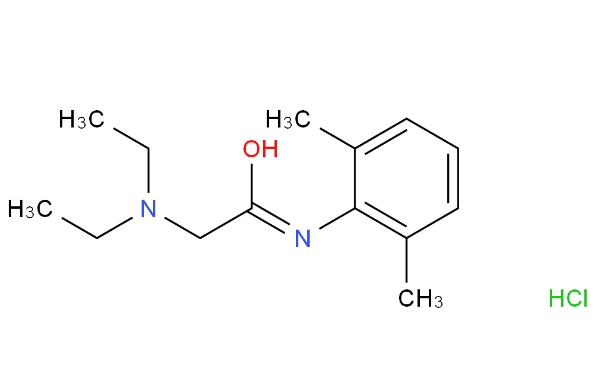CAS 137-58-6
Chinese name: Lidocaine
Chinese aliases: N-diethylaminoacetyl-2,6-dimethylaniline; N-Diethylacetyl-2,6-dimethylaniline; 2-Diethylamino-N-(2,6-dimethylphenyl)acetamide.
English name: lidocaine
English alias: L-Caine; Leostesin; 2-Diethylamino-N-(2,6-dimethylphenyl)acetamide; Esracaine; 2-diethylamino-2',6'-acetoxylidide;
CAS number: 137-58-6
Molecular Formula: C14H22N2O
Molecular Weight: 234.337
Exact Mass: 234.17300
PSA:32.34000
LogP:2.65670
Physical and chemical properties
Appearance and properties: white crystalline powder
Density: 0.9944 g/cm3
Melting point: 66-69 °c
Boiling point: 372.7ºC at 760mmHg
Flash point: 179.2ºC
Stability: Stable. Incompatible with robust oxidants.
Storage conditions: Store in a cool and dry place. Keep the container closed when no longer in use.
Vapour pressure: 4.28E-05mmHg at 25°C
Pharmacology and toxicology
This product is an amide neighborhood anesthetic. After blood absorption or intravenous administration, it has apparent excitation and inhibition biphasic impact on the central worried system, and there can be no precursor excitement, when the blood awareness is low, analgesia and drowsiness, and the ache threshold is increased; With the amplify of dose, the impact or toxicity increases, and there is an anticonvulsant impact at the awareness of subtoxic blood drugs; When the blood awareness exceeds 5 mg·mL-1, convulsions can occur. At low doses, this product can promote the outflow of K+ in cardiomyocytes, minimize the auto-discipline of myocardium, and have anti-ventricular arrhythmic effect; At therapeutic doses, there is no tremendous impact on the electrical pastime of cardiomyocytes, atrioventricular conduction and contraction of myocardium; Further make bigger in blood attention can purpose slowing of cardiac conduction velocity, atrioventricular block, inhibition of myocardial contractility and limit of cardiac output.
Pharmacokinetics
Oral bioavailability is low, and the first hepatic impact is sharply reduced. Absorbed absolutely after intramuscular injection. After absorption, it rapidly distributes into the heart, brain, kidneys and different tissues prosperous in blood supply, and then distributes to fats and muscle tissue. The obvious extent of distribution is about 1 L/kg, and the quantity of distribution is decreased in coronary heart failure. The protein binding price is about 51%. Smokers can have greater costs of binding than non-smokers.
It takes impact 5~15 minutes after intramuscular injection, and reaches the therapeutic attention in 15~20 minutes after a intramuscular injection of 200mg, lasting 60~90 minutes;
It takes impact without delay after intravenous injection (about 45~90 seconds) and lasts for 10~20 minutes. The therapeutic plasma attention is 1.5~5μg/mL, and the poisoning blood awareness is extra than 5μg/mL. Continue intravenous drip for 3-4 hours to attain steady-state blood concentration, acute myocardial infarction takes 8~10 hours. 90% metabolized via the liver, metabolites monoethylglycylxylxylaniline (MEGX) and glycylxylbenzilide (GX) have pharmacological activity, non-stop intravenous drip for greater than 24 hours, metabolites can produce therapeutic and poisonous effects. The half-life after intravenous injection α about 10 minutes, and the β is about 1~2 hours. The GX half-life is about 10 hours longer, and the MEGX half-life is comparable to that of the unique drug. Patients with heart failure, liver disease, the aged and non-stop intravenous drip for greater than 24~36 hours, the clearance of this product is slowed down. Excreted with the aid of the kidneys, 10% as the authentic drug, 58% as metabolites (GX), can now not be eliminated by way of hemodialysis.
The efficacy and length of neighborhood anesthesia of lidocaine are greater than that of procaine, however the toxicity is additionally greater. The deethyl metabolite (monoethylglycinamide xylene) metabolized in the liver nonetheless has nearby anesthetic properties, will increase toxicity, and is in addition degraded by using amidase and excreted with urine, and 10% of the dosage is excreted in its authentic form.
Clinical application
It is appropriate for acute ventricular arrhythmias triggered via acute myocardial infarction, surgery, digitalis poisoning and cardiac catheterization, together with ventricular untimely beats, ventricular tachycardia and ventricular fibrillation. Secondly, it is additionally used for repute epilepticus who does no longer reply to different anticonvulsants and neighborhood or neuraxial anesthesia. It can additionally relieve tinnitus.


Related News
Submitted successfully
We will contact you as soon as possible







